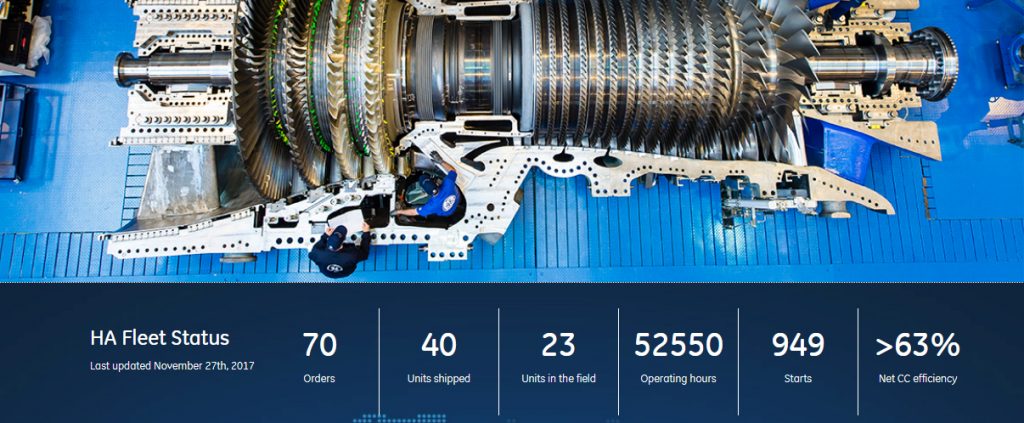GE’s largest and most efficient gas turbine the HA, nicknamed HArriet, has broken its own net efficiency record. Beating previous orders at 63.7% efficiency, the HA is now available at 64% under conditions recorded at a test plant in Greenville, South Carolina. The company attributes this feat to “combustion breakthroughs through constant innovation,” and applying additive manufacturing to a number of the turbine’s key components.
HA efficiency in figures
GE H-Class gas turbines are used by over 70 customers in combined cycle power plants around the world. By redirecting the waste heat generated by a gas turbine to a steam turbine, combined cycle power plants produce 50 % more electricity from the same fuel, i.e. natural gas, than a traditional simple-cycle plant.
Just 18 months prior to this new record, a 9HA.01 turbine earned a Guinness World Record for powering the world’s most efficient combined-cycle power plant. At the site in Bouchain, France, the GE 9HA produces enough energy to power 680,000 homes with an output of 605 MW.
The 64% efficient 9HA.02 turbine clocks a total output of 826 megawatts in a combined cycle configuration. According to GE Power estimates, the additional units of power translates into “to millions in fuel savings for customers globally.”

3D printed efficiency
Joe Mastrangelo, president and CEO of GE’s Gas Power Systems, says “The HA is our most advanced gas turbine technology, and we’ve never stopped pushing the boundaries of what it can do.”
Design of the engine’s combustion system was optimized using metal 3D printing. With more complex geometries, engineers improved the premixing of fuel and air in the turbine to achieve maximized productivity.
Mastrangelo adds, “With the ability to deliver 64 percent efficiency, GE is proud to achieve an industry first and offer customers the most efficient gas technology available in the world today.”
Three-tier thinking
Through acquiring Concept Laser and Arcam in the biggest 3D printing industry deal to date, and releasing millions of dollars to encourage more businesses to adopt the technology, it is clear that additive manufacturing is a key driver for the future of GE.
Speaking at 2017’s Defence IQ Additive Manufacturing for Aerospace, Defence and Space (AMADS) conference, Edward Herderick, GE Corporate Supply Chain and Operations described a three tier process of additive thinking. This is defined by Herderick in grades from part replacement, to consolidation and finally specific Design for Additive Manufacturing (DfAM). In GE’s cross-industry operations, particularly in aerospace, 3D printing is finding integration at each of these tiers.

Turbines in aviation
The company’s 3D printed fuel nozzle containing LEAP-1C jet engine became a landmark piece in the company’s additive history attaining FAA and EASA certification in December 2016. At the 2017 Paris Air Show GE went on to sell 1,658 LEAP and CFM56 engines at an estimated value of over $27 billion.
Additive manufacturing has also been rolled out in the development of GE’s next generation helicopter and business jet engines, affirming a commitment to its success.
According to GE Power, energy turbine development “remains on track to achieve 65 percent efficiency by the early 2020s, continuing the HA’s legacy as the most advanced H-class technology in the world.”
Never miss a story – subscribe to the 3D Printing Industry newsletter, follow us on Twitter, and like us on Facebook.
Featured image shows the GE 9HA gas turbine. Image via GE Power


